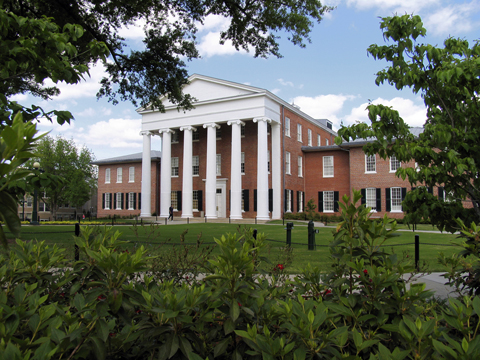 June marked the beginning of my Jesus year, and it has been an interesting month to say the least, which I have found to be variously amusing and disappointing. I know some of y’all have some burning questions, so who am I not to spit to put your eyebrows out? This is long, though. Much longer than the post the University of Memphis put up about my employment. Pull up a chair.
June marked the beginning of my Jesus year, and it has been an interesting month to say the least, which I have found to be variously amusing and disappointing. I know some of y’all have some burning questions, so who am I not to spit to put your eyebrows out? This is long, though. Much longer than the post the University of Memphis put up about my employment. Pull up a chair.
Riots and Rumors of Riots: Lessons from the University of Mississippi
On the night of the 2012 election, when Barack Obama was elected to a second term, some students at the University of Mississippi burned Obama campaign signs. They had procured these signs as they tore through the halls of dorms ripping them down. Under the cover of swiftness and invisibility, they moved through the halls gathering their loot while black students were captive and largely unaware inside their dorms.
The University’s public relations machinery, slumbering and oblivious—although inexplicably so, given that similar incidents took place when Obama was elected for the first time in 2008—scrambled to tamp down the emerging rumors and headlines.
The University’s silencing machinery of shade and spin had lacked its usual assassin-like precision, overtaken by the swift sprint of social media outlets, from Twitter to Facebook. A cell-phone quality picture of a circle of white male students burning an Obama sign accompanied every story and Facebook post. The papers said, “riot.” Equivocators said, “protest.”
The increasing popularity and facility of social media proved faster, swifter, than those feet running through halls snatching signs, faster even than the University’s infamously powerful PR spin. People were free to draw conclusions.
Well-intentioned whites, in pain, perhaps, for their black colleagues and friends, but burdened more by chagrin than outrage at inequality, quickly organized a candlelight vigil under the tenuous idea of “one Mississippi.” Scores of people raised candles outside of the same building where Meredith enrolled 50 years ago, escorted by armed guards, after a campus “riot”—or, if some prefer, “protest,”—left two people dead, dozens injured, and a state, a region, and a nation painfully aware of the vitriol and depth of white supremacy.
As I watched the events unfold on social media, my immediate reaction was one of sadness for the black students and colleagues I had befriended over my three years at the University of Mississippi. I was also sad for white colleagues who were powerless against the institution, despite their white privilege, and forced into silence and complicity with the institution’s mandate of white patriarchal supremacy.
I was neither shocked nor surprised by the events, as the University of Mississippi encourages this kind of behavior through its consistent inaction against a host of bad behaviors, from racial slurs scrawled in graffiti in dorm elevators to gross mishandling of cases of sexual harassment and rape. This institutional inaction is bolstered by the University’s identity as a bastion of the traditional, Old South: a white South where Dixie plays, confederate flags wave, and black people are subservient.
To be fair, the University has attempted to address these vestiges of a racist past. It stopped the band’s belting out of Dixie at football games and the flying of confederate flags, and has made overtures towards recruiting and retaining black faculty. Yet, as Faulkner instructs us, the past is not dead nor even past; we are haunted by these vestiges, as black women labor in the kitchens of white fraternity houses, “heritage not hate” dominates discussions of the South, and the wounds of the loss of the Northern War of Aggression are still oozing.
Thus, the University’s efforts to eradicate the past notwithstanding, Ole Miss’s identity as a place where men are men, women are women, and Nigras know their place is still functional for its enrollment and financial bottom line, attracting white students from all over the country and satiating powerful (but invisible) white alumni and big donors.
Although my training as a sociologist taught me well the workings of institutional power, at the University of Mississippi, I received an education by fire. I met black faculty so traumatized by their experiences there that they had either sublimated rage for the purposes of survival or been consumed by the rage to the point of intellectual and emotional paralysis.
I met worried white colleagues, fearful of if or when one of us would erupt, knowing we would be cast as privately troubled individuals, rather than symptomatic of a public problem.
I met oblivious white faculty.
I met white faculty saviors, eager to solve the problem and save the day, even at the expense of alienating black colleagues. I met underpaid staff called into work when their babies were sick, who had to come lest they risk their pittance and their jobs.
I met black students consumed by the most terrible pathologies, whose quest to belong and disbelieve the University’s history and identity led them to defend the institution fervently.
I met black students unaware of the trauma the institution was enacting upon them. I met black students who were painfully aware of that trauma, who were in pain because of it, but who determined to do as much as they could within their limited powers.
Meanwhile, the official message was that the University of Mississippi was one of the best places to work with one of the most beautiful campuses. Oxford is a wonderful town. The University is committed to recruiting and retaining diverse faculty.
The first black student body president is elected. The University hosts a presidential debate. The University remembers Meredith’s sacrifice. The first black teacher of the year is selected. The University is committed to fairness. The University will not tolerate discrimination. The first black homecoming queen is elected. The University commemorates the Civil Rights Movement. The University acknowledges that it still has a ways to go, but has nonetheless come a long way.
See Jane run. Jane is fast. But she cannot outrun white supremacy.
Over my time at the University of Mississippi, and in particular in the second two years, I became physically and psychologically ill. I knew something was wrong when, in response to a student’s angry question of why “Mexicans” should not have to learn English, I laughed hysterically and uncontrollably for two minutes. I was co-teaching the course, and thankfully, my interlocutor was able to take over until I calmed down.
When I felt a strong urge to be physically violent with a student who sent a threatening email and angrily paced outside of my office to confront me about comments on a paper—comments that I had not, in fact, written, but that had been written by my colleague—I knew something was wrong.
I had angry outbursts and crying spells. I ate to keep from shouting and crying. I gained 30 pounds. I developed a serious kidney infection because I would pathologically drive the 30 miles to Batesville—the first major town on my way home to Memphis—to use a gas station bathroom rather than linger a minute on the University of Mississippi’s campus or in Oxford to relieve myself after a long day at work.
I developed a baseball-sized, rock-hard cyst in my breast. I continued to dissemble, though. I worked with students, attended meetings, and wrote. But I had been overtaken and lapped by white supremacy.
The climate at the University of Mississippi reflects the broader mood and character of whiteness and thus is instructive in its ability to signal power’s next moves. Someone must be punished for tarnishing the University’s image in an historic year—the commemoration of Meredith, integration, and Civil Rights—and a few white students will be trotted out and sacrificed to meet this demand. Perhaps some black students, too, will be punished for reverse rioting/protesting.
The institution will shore up its public relations machinery; surely, someone will be appointed to always be on call to respond to these kinds of incidents. But the institution, like whiteness, will not change. It will not turn inward. It will not reflect. That is not the nature of institutions.
Further, the climate at the University of Mississippi reflects the climate at many institutions, academic and corporate. My experience, in this respect, is not unique. Faculty of color at a number of institutions are marginalized and under assault from institutions that benefit tremendously from their presence but cannot seem to invest reciprocally in their success as faculty and health as people. This contributes to stagnant numbers of faculty of color overall, even as recruitment of faculty of color increases.
Faculty of color not only move about between institutions, but also exit the academic field entirely, opting to start non-profits, small businesses, and other ventures where they can exercise more autonomy and limit their experiences of racial microaggressions.
Still, as institutions like the University of Mississippi continue to focus on recruitment, rather than on fundamentally changing campus climates, the face of administration, and practices that disadvantage and discourage faculty of color (and indeed most faculty who are not single white men), little will be done to ease the exodus of people of color.
Yet, institutions can and do move, albeit it slowly, especially in response to external threats. The Republican Party, for instance, trounced by “demographics”—media code for people of color, women, LGBT persons, and progressive urbanites—can be a formidable force in 2016 by basing their campaign strategy not on overt white patriarchal supremacy, but rather benign white patriarchal supremacy, especially that cloaked in the colored faces of Bobby Jindal and Marco Rubio.
If it is to continue to be the Demographic Party, the Democratic Party will need to effect real change on issues of sustainability and equality rather than teetering on in its typical center-right, neoliberal fashion. A third party, as a new(-er) institution, could capitalize handily on government intractability, people’s dissatisfaction, and grassroots momentum to envision possibilities for a more equitable, responsible, and sustainable nation-state.
As faculty of color, we have a responsibility to advocate for all students, and a disproportionate responsibility to champion marginalized students, including students with disabilities, students of color, and LGBT students. We have an obligation to University staff of color, who labor alongside us often without our relative privilege and autonomy. We also, as long as we are in them, have a responsibility to institutions—even when they do not behave responsibly—to demonstrate the importance of change and offer our distinct insights. If we all push, the institution may move a centimeter.
The University of Mississippi reinforced for me that classic sociological lesson about the rigidity of institutions. It also reaffirmed my commitment to and investment in research, teaching, mentoring, and even (certain kinds of) service.
I built lifelong friendships with students, faculty, and staff there, important relationships that have shaped my scholarship and my approach to my academic work. Perhaps most importantly, it taught me that I must care for myself. After all, if I drop dead with an acute case of allergic white supremacitis, the institution will continue on in all of its glorious inertia.
*This essay was originally published in the November 2012 edition of the Association of Black Sociologists Newsletter, The Griot.
